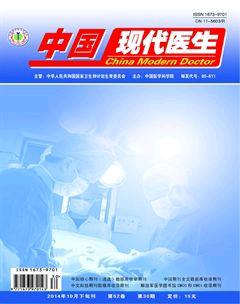基质金属蛋白酶—1基因启动子区(—1607)基因多态性与肾移植后环孢素诱导牙龈增生的相关性
戴巧群+单海琴+任雨+吴寅+孙科家+叶小磊
[摘要] 目的 研究MMP1基因单核苷酸多态(-1607)1G/2G与环孢素诱导牙龈增生(CsA-GO)发生风险的关系。 方法 以聚合酶链反应和限制性片段长度多态性(PCR-RFLP)分析方法,分别检测42例环孢素诱导牙龈增生病人和118位正常对照者MMP1(-1607)1G/2G多态的基因型;以Logistic回归模型计算不同基因型与环孢素诱导牙龈增生风险的关系。 结果 环孢素诱导牙龈增生病例组的MMP1(-1607)3种基因型频率分布与对照组无显著差异(P=0.37)。携带MMP1(-1607)2G基因型者发生环孢素诱导牙龈增生的风险比携带1G基因型者高1.38倍(95%CI=0.81~2.36,P=0.24),而1G基因型与环孢素诱导牙龈增生风险无关。 结论 MMP1基因启动子区(-1607)1G/2G单核苷酸多态性可能并非环孢素诱导牙龈增生的遗传易感因素,携带2G基因型的患者发生CsA-GO的风险有增高趋势。
[关键词] 牙龈增生;基质金属蛋白酶;基因多态性;遗传易感性
[中图分类号] R781.4 [文献标识码] A [文章编号] 1673-9701(2014)30-0152-04
环孢菌素(Cyclosporine,CsA)作为临床常见的免疫抑制剂,主要应用于器官移植后的抗宿主排异反应,在临床应用过程中可诱发药物性牙龈增生(drug-induced gingival overgrowth,DGO),由CsA诱导的牙龈增生(CsA-GO)在肾移植后患者中发病率可以高达30%~50%。牙龈增生后不仅可以影响患者口腔的咀嚼以及美观,而且为口腔微生物的生长提供了较佳的环境,可以增加免疫功能抑制患者系统感染的风险,导致严重并发症的发生[1]。对使用CsA患者进行牙龈增生易感性研究,可以减少易感患者发生牙龈增生的可能性,为免疫抑制剂的使用提供指导。
正常牙龈由上皮层和固有层构成,前者属于上皮组织,附着于牙釉质或牙骨质的表面,后者主要为结缔组织,包括细胞和细胞外基质两部分,胞外基质中含有大量的胶原纤维,约占细胞外基质的60%。牙龈组织中的胶原I主要来源于牙龈成纤维细胞,基质金属蛋白酶-1是负责I型胶原降解的主要蛋白水解酶,正常情况下,胶原I合成和降解处于平衡状态。以往不少研究认为,CsA-GO发生可能与牙龈组织胶原代谢失衡有关,即合成-降解失衡[2]。有研究发现,在环孢素作用下基质金属蛋白酶-1(MMP1)活性下调,牙龈结缔组织I型胶原降解受抑制,产生的胶原因无法降解而堆积[3,4]。对MMP1基因活性调节位点的研究显示,在该基因启动子区域上游1607位点1G/2G的多态性可以直接影响MMP-1的转录活性和蛋白表达水平[5],并与多种疾病的易感性存在相关性,如结直肠癌[6]、子宫内膜异位症[7]等。而在口腔领域,Santos等发现种植体失败患者2G型的比例明显高于对照组[8,9]。国内外不少研究发现[10,11],该位点多态性与口腔鳞癌的易感性密切相关。以上研究说明,MMP1的活性影响到I型胶原代谢。目前,国内外尚未有关于MMP1多态性与环孢素诱导的牙龈增生的研究报道,因此,本研究着重探讨MMP1上游启动子区域-1607位点多态性与环孢素诱导的牙龈增生的相关性。
1 材料与方法
1.1 一般资料
选取我院2011年1月~2013年12月期间服用CsA达到6个月以上的肾移植患者160例,其中男125例,女35例,年龄18~60岁,术后最长时间6年,近3个月来未经任何牙周治疗,根据是否存在牙龈增生分为牙龈增生组42例和未诱发牙龈增生组(对照组)118例,牙龈增生程度评估在Angelopoulos和Goaz等人方法基础上有所调整,即0=无牙龈增生,1分=轻度牙龈增生;牙龈边缘增厚,龈袋内有小叶状颗粒增生,增生的牙龈覆盖少于1/3牙冠;2分=中度牙龈增生;增生牙龈覆盖至牙冠中部;3分=重度牙龈增生;2/3以上牙冠被增生牙龈覆盖或全附着龈均有增生[12]。评估研究对象发现,在牙龈增生组中为(1.96±0.61),在对照组中为(0.02±0.01),差异具有统计学意义(P<0.05)。血液中环孢素浓度在增生组中为(333.0±111.8)μg/mL,对照组中为(288.8±80.1)μg/mL,差异无统计学意义(P>0.05)。
1.2 DNA提取
抽取患者前臂静脉血2 mL,以枸橼酸钠抗凝,采用北京天根TIANamp 血液基因组DNA提取试剂盒(DP318),提取外周血中白细胞DNA,方法参考试剂盒说明书。
1.3 基因多态性检测
MMP1基因分型:采用聚合酶链反应限制性片段长度多态性(PCR-RFLP)方法对MMP1基因上游-1607区域进行扩增。MMP1(-1607)1G/2G引物设计以及方法按文献报道进行[9]。扩增含该多态位点的PCR引物序列为上游引物5′-TGAGGAAATTGTAGTTAAATCCTTAGAAAG -3′和下游引物5′-TGAGGAAATTGTAGTTAAATCCTTAGAAAGTCTT -3′。PCR反应体系设置如下。北京百泰克2×Power Taq PCR MasterMix 12.5 μL(含相关的PCR Buffer以及Taq聚合酶),上下游引物各0.2 μL,DNA模板1 μL,其余用水补齐反应体积到25 μL;PCR条件为:95℃变性2 min,然后94℃30 s,53℃30 s,72℃50 s进行30个循环后,72℃延伸6 min。由于在上游引物21位中引入错配碱基CC,因此产物能用于BslI的酶切,大小为130bp。取15μL PCR产物与限制性核酸内切酶BslI(New England BioLabs)于37℃孵育3 h。酶切产物于3.0%琼脂糖凝胶电泳分离。经过酶切后,1G/1G基因型产生的片段大小为130bp;2G/2G产生27bp和103bp;杂合子则产生大小分别为130bp、103bp和27bp 的3个片段。每一批PCR反应均以蒸馏水替代DNA模板作为阴性对照,并设置杂合子患者为内对照,用于判断每次酶切反应是否彻底,并随机抽取10%的DNA标本对PCR产物进行测序分析以判断方法的正确性。endprint
1.4数据及统计分析
得到患者以及对照组不同分型基因频率后,分析是否符合Hardy-Weinberg平衡定律。同时采用SPSS 10.0软件进行数据分析,用χ2检验比较各基因型频率在病例组与对照组之间的差异。用比值比(oddsratio,OR)及其95%可信区间(confidence interval,CI)表示携带某个基因型发生环孢素诱导牙龈增生的风险度。OR值以非条件Logistic回归计算,并经性别、年龄状况校正。
2 结果
见表1。在42个牙龈增生组中,MMP1(-1607)1G/1G、1G/2G和2G/2G这3种基因型的分布频率分别为9.5%、40.5%和50.0%,在118个正常对照中,1G/1G、1G/2G和2G/2G的分布频率分别为16.1%、41.5%和42.4%, 2个不同分组基因频率分布经Hardy-Weinberg平衡定律(H-W test)检测,显示均符合H-W 分布(P>0.05)。Pearson卡方检验表明,这三种基因型在牙龈增生和对照组中差异无统计学意义(χ2=1.99,P=0.37)。Logistic回归分析结果表明,以MMP1(-1607)1G/1G基因型携带者为参照,携带2G基因型者罹患牙龈增生患者的OR风险为携带1G基因的1.38倍(95%CI 0.81~2.36),因此,携带2G基因的患者发生CsA-GO的风险增加,但由于CI下限为0.81并未超过1,还不足以认为2G为易感的风险因素。
3 讨论
CsA-GO的发生常与牙龈下结缔组织中胞外基质的堆积有关,其构成以I型胶原为主,另外也存在3型胶原以及蛋白多糖等的积聚。牙龈组织中的胶原降解主要通过基质金属蛋白酶-1和-3实现。基质金属蛋白酶家族(MMPs)是一组锌离子或钙离子依赖酶,以无活性的酶原形式分泌后可通过纤溶酶、胰蛋白酶或其他因子刺激后,剪接活化并降解1种或者多种细胞外基质成分,在细胞外基质代谢调节中起重要作用。CsA-GO的发生常与胶原代谢紊乱相关,其中MMPs活性以及表达受到较多研究的关注。Rutter等[13]在MMP1基因启动子区上游1607位发现一个插入/缺失多态性,多出鸟嘌呤,使得位点区域序列变为5'-GGA-3',该型就是2G型,而只有1个鸟嘌呤的为1G型。该位点SNP普遍存在,正常个体中3种基因型比例分别为1G/1G 30%、1G/2G 30%、2G/2G 3%~40%,在癌细胞中2G/2G型的比例可提高到63.5%,与较强的基质降解并促进癌细胞转移密切相关。其中2G等位基因形成一个转录因子ETS的核心结合序列,研究显示ETS-1可以提高MMP-1启动子活性达到10倍[14],同时也发现ETS可以通过动态调节MMP1和TIMP1酶系统的平衡而影响胶原的沉积,进而参与到化疗药物诱导的肾病ECM的重塑过程[15,16]。另一方面,1G等位基因则使得MMP1转录显著降低。
由于MMP1基因启动子多态性使得MMP1的表达在不同人中存在较大的差异,因此不同的人对CsA所诱导的牙龈增生也存在易感性的差异。而且CsA可以抑制来自牙龈成纤维细胞中MMP-1的活性,且呈现浓度依赖性[3]。因此,CsA可以使得MMP1的表达和活性在不同人中存在一定程度的下降,进而引起胶原无法被有效降解,引起堆积增加。本研究显示,牙龈增生以及未增生组中MMP1上游(-1607)基因多态性基因之间的分布无显著差异,提示我们这一位点的多态性可能和CsA-GO发病无显著关系,进一步的Logistic回归分析显示,携带1G基因型的患者发生CsA-GO的风险为携带2G基因型患者的0.73倍,95%CI为0.42~1.24,因此说明该位点并非发生CsA-GO的危险因素。
MMP1启动子多态性与口腔疾病的报道主要集中于与牙周炎发展的相关性,但是研究结果存在争议,部分研究认为,含有2G/2G的患者发展为重度慢性牙周炎的风险远高于1G等位基因的患者。也有一些研究显示MMP1启动子区域-1607位点多态性并非慢性牙周炎的风险因素,在不同分组中不存在统计学差异[17]。这些结果提示由于不同研究的种族差异、实验样本容量的差异以及试验方法的不同,使得SNP与口腔疾病如牙周炎发展中的作用研究还处于探讨阶段。由于牙龈胶原代谢还和MMP家族中MMP3的活性有关,而MMP3和MMP1都定位于11q22.3上,两者的分布频率和连锁不平衡性可能也影响到口腔疾病的易感性。
总之,本研究首次在CsA-GO患者中探讨了MMP1基因启动子区域位点多态性与疾病发展的相关性。根据现有样本结果分析显示,MMP1基因启动子区的功能性单核苷酸多态(-1607) 1G/2G与环孢素诱导牙龈增生的发生无显著相关,但是携带2G等位基因的患者发生CsA-GO的风险增加。由于本研究的样本量相对较小,还需要进一步扩大研究对象,并且收集更多的临床预后资料,以探讨该基因其他位点多态性以及相关基因如MMP3多态性对环孢素诱导牙龈增生易感性的相关性。
[参考文献]
[1] Jiang L,Gao MJ,Zhou J,et al. Serum cyclophilin A concentrations in renal transplant recipients receiving cyclosporine A:Clinical implications for gingival overgrowth[J].Oral Surg Oral Med Oral Pathol Oral Radiol,2013,116(4):447-754.
[2] Dannewitz B,Tomakidi P,Syagailo Y,et al. Elevation of collagen type I in fibroblast-keratinocyte cocultures emphasizes the decisive role of fibroblasts in the manifestation of the phenotype of cyclosporin A-induced gingivalovergrowth[J].J Periodontal Res,2009,44(1):62-72.endprint
[3] Sonmez S,Cavdar C,Gunduz C,et al. Do MMP-1 levels of gingival fibroblasts have a role in the gingival overgrowth of cyclosporine-treated patients[J]. Transplant Proc,2008, 40(1):181-183.
[4] 马肃,刘培红,李延武,等. 环孢菌素对大鼠牙龈结缔组织胶原及TIMP-1蛋白表达影响的实验研究[J]. 中国美容医学,2011,(9):1398-1400.
[5] McCready J,Broaddus WC,Sykes V,et al. Association of a single nucleotide polymorphism in the matrix metalloproteinase-1 promoter with glioblastoma[J]. Int J Cancer,2005,117(5):781-785.
[6] Elander N,Soderkvist P,Fransen K. Matrix metalloproteinase (MMP) -1,-2,-3 and -9 promoter polymorphisms in colorectal cancer[J].Anticancer Res,2006,26(1B):791-795.
[7] Kang S,Wang Y,Zhang JH,et al. Single nucleotide polymorphism in the matrix metalloproteinases promoter is associated with susceptibility to endometriosis and adenomyosis[J]. Zhonghua Fu Chan Ke Za Zhi,2005,40(9):601-604.
[8] Santos MC,Campos MI,Souza AP,et al. Analysis of MMP-1 and MMP-9 promoter polymorphisms in early osseointegrated implant failure[J]. Int J Oral Maxillofac Implants,2004,19(1):38-43.
[9] Dereka X,Mardas N,Chin S,et al. A systematic review on the association between geneticpredisposition and ental implant biological complications[J]. Clin Oral Implants Res,2012,23(7):775-788.
[10] Cao ZG,Li CZ. A single nucleotide polymorphism in the matrix metalloproteinase-1 promoter enhances oral squamous cell carcinoma susceptibility in a Chinese population[J]. Oral Oncol,2006,42(1):32-38.
[11] Stott-Miller M,Houck JR,Lohavanichbutr P,et al. Tumor and salivary matrix metalloproteinase levels are strong diagnostic markers of oral squamous cell carcinoma[J]. Cancer Epidemiol Biomarkers Prev,2011,20(12):2628-2636.
[12] Angelopoulos AP. Diphenylhydantoin gingival hyperplasia. A clinicopathological review. 1. Incidence,clinical features and histopathology[J]. Dent J,1975,41(2):103-106.
[13] Rutter JL,Mitchell TI,Buttice G,et al. A single nucleotide polymorphism in the matrix metalloproteinase-1 promoter creates an Ets binding site and augments transcription[J]. Cancer Res,1998,58(23):5321-5325.
[14] Westermarck J,Seth A,Kahari VM. Differential regulation of interstitial collagenase (MMP-1) gene expression by ETS transcription factors[J]. Oncogene,1997,14(22):2651-2660.
[15] Nazneen A,Razzaque MS,Liu D,et al. Possible role of Ets-1 and MMP-1 in matrix remodeling in experimental cisplatin nephropathy[J]. Med Electron Microsc,2002,35(4):242-247.
[16] 袁伟杰,王轩. Ets-1在肾脏纤维化中的双向作用及其机制[J]. 中国中西医结合肾病杂志,2011,(12):1035-1037.
[17] 黄满英,苏小鹏,付云. MMP-1基因启动子区SNP与牙周炎关系的研究进展[J]. 牙体牙髓牙周病学杂志,2009,(1):42-45,49.
(收稿日期:2014-05-21)endprint
[3] Sonmez S,Cavdar C,Gunduz C,et al. Do MMP-1 levels of gingival fibroblasts have a role in the gingival overgrowth of cyclosporine-treated patients[J]. Transplant Proc,2008, 40(1):181-183.
[4] 马肃,刘培红,李延武,等. 环孢菌素对大鼠牙龈结缔组织胶原及TIMP-1蛋白表达影响的实验研究[J]. 中国美容医学,2011,(9):1398-1400.
[5] McCready J,Broaddus WC,Sykes V,et al. Association of a single nucleotide polymorphism in the matrix metalloproteinase-1 promoter with glioblastoma[J]. Int J Cancer,2005,117(5):781-785.
[6] Elander N,Soderkvist P,Fransen K. Matrix metalloproteinase (MMP) -1,-2,-3 and -9 promoter polymorphisms in colorectal cancer[J].Anticancer Res,2006,26(1B):791-795.
[7] Kang S,Wang Y,Zhang JH,et al. Single nucleotide polymorphism in the matrix metalloproteinases promoter is associated with susceptibility to endometriosis and adenomyosis[J]. Zhonghua Fu Chan Ke Za Zhi,2005,40(9):601-604.
[8] Santos MC,Campos MI,Souza AP,et al. Analysis of MMP-1 and MMP-9 promoter polymorphisms in early osseointegrated implant failure[J]. Int J Oral Maxillofac Implants,2004,19(1):38-43.
[9] Dereka X,Mardas N,Chin S,et al. A systematic review on the association between geneticpredisposition and ental implant biological complications[J]. Clin Oral Implants Res,2012,23(7):775-788.
[10] Cao ZG,Li CZ. A single nucleotide polymorphism in the matrix metalloproteinase-1 promoter enhances oral squamous cell carcinoma susceptibility in a Chinese population[J]. Oral Oncol,2006,42(1):32-38.
[11] Stott-Miller M,Houck JR,Lohavanichbutr P,et al. Tumor and salivary matrix metalloproteinase levels are strong diagnostic markers of oral squamous cell carcinoma[J]. Cancer Epidemiol Biomarkers Prev,2011,20(12):2628-2636.
[12] Angelopoulos AP. Diphenylhydantoin gingival hyperplasia. A clinicopathological review. 1. Incidence,clinical features and histopathology[J]. Dent J,1975,41(2):103-106.
[13] Rutter JL,Mitchell TI,Buttice G,et al. A single nucleotide polymorphism in the matrix metalloproteinase-1 promoter creates an Ets binding site and augments transcription[J]. Cancer Res,1998,58(23):5321-5325.
[14] Westermarck J,Seth A,Kahari VM. Differential regulation of interstitial collagenase (MMP-1) gene expression by ETS transcription factors[J]. Oncogene,1997,14(22):2651-2660.
[15] Nazneen A,Razzaque MS,Liu D,et al. Possible role of Ets-1 and MMP-1 in matrix remodeling in experimental cisplatin nephropathy[J]. Med Electron Microsc,2002,35(4):242-247.
[16] 袁伟杰,王轩. Ets-1在肾脏纤维化中的双向作用及其机制[J]. 中国中西医结合肾病杂志,2011,(12):1035-1037.
[17] 黄满英,苏小鹏,付云. MMP-1基因启动子区SNP与牙周炎关系的研究进展[J]. 牙体牙髓牙周病学杂志,2009,(1):42-45,49.
(收稿日期:2014-05-21)endprint
[3] Sonmez S,Cavdar C,Gunduz C,et al. Do MMP-1 levels of gingival fibroblasts have a role in the gingival overgrowth of cyclosporine-treated patients[J]. Transplant Proc,2008, 40(1):181-183.
[4] 马肃,刘培红,李延武,等. 环孢菌素对大鼠牙龈结缔组织胶原及TIMP-1蛋白表达影响的实验研究[J]. 中国美容医学,2011,(9):1398-1400.
[5] McCready J,Broaddus WC,Sykes V,et al. Association of a single nucleotide polymorphism in the matrix metalloproteinase-1 promoter with glioblastoma[J]. Int J Cancer,2005,117(5):781-785.
[6] Elander N,Soderkvist P,Fransen K. Matrix metalloproteinase (MMP) -1,-2,-3 and -9 promoter polymorphisms in colorectal cancer[J].Anticancer Res,2006,26(1B):791-795.
[7] Kang S,Wang Y,Zhang JH,et al. Single nucleotide polymorphism in the matrix metalloproteinases promoter is associated with susceptibility to endometriosis and adenomyosis[J]. Zhonghua Fu Chan Ke Za Zhi,2005,40(9):601-604.
[8] Santos MC,Campos MI,Souza AP,et al. Analysis of MMP-1 and MMP-9 promoter polymorphisms in early osseointegrated implant failure[J]. Int J Oral Maxillofac Implants,2004,19(1):38-43.
[9] Dereka X,Mardas N,Chin S,et al. A systematic review on the association between geneticpredisposition and ental implant biological complications[J]. Clin Oral Implants Res,2012,23(7):775-788.
[10] Cao ZG,Li CZ. A single nucleotide polymorphism in the matrix metalloproteinase-1 promoter enhances oral squamous cell carcinoma susceptibility in a Chinese population[J]. Oral Oncol,2006,42(1):32-38.
[11] Stott-Miller M,Houck JR,Lohavanichbutr P,et al. Tumor and salivary matrix metalloproteinase levels are strong diagnostic markers of oral squamous cell carcinoma[J]. Cancer Epidemiol Biomarkers Prev,2011,20(12):2628-2636.
[12] Angelopoulos AP. Diphenylhydantoin gingival hyperplasia. A clinicopathological review. 1. Incidence,clinical features and histopathology[J]. Dent J,1975,41(2):103-106.
[13] Rutter JL,Mitchell TI,Buttice G,et al. A single nucleotide polymorphism in the matrix metalloproteinase-1 promoter creates an Ets binding site and augments transcription[J]. Cancer Res,1998,58(23):5321-5325.
[14] Westermarck J,Seth A,Kahari VM. Differential regulation of interstitial collagenase (MMP-1) gene expression by ETS transcription factors[J]. Oncogene,1997,14(22):2651-2660.
[15] Nazneen A,Razzaque MS,Liu D,et al. Possible role of Ets-1 and MMP-1 in matrix remodeling in experimental cisplatin nephropathy[J]. Med Electron Microsc,2002,35(4):242-247.
[16] 袁伟杰,王轩. Ets-1在肾脏纤维化中的双向作用及其机制[J]. 中国中西医结合肾病杂志,2011,(12):1035-1037.
[17] 黄满英,苏小鹏,付云. MMP-1基因启动子区SNP与牙周炎关系的研究进展[J]. 牙体牙髓牙周病学杂志,2009,(1):42-45,49.
(收稿日期:2014-05-21)endprint

